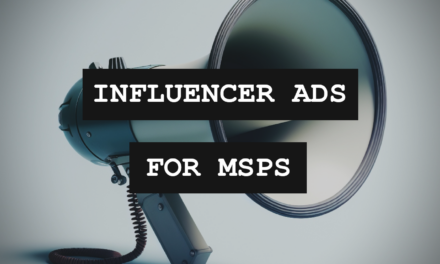Setting Boundaries To Expedite Creativity
When I had the idea to launch MSP Spark, my first instinct was to put myself to the test. If I was going to be able to offer 10 fresh content ideas each and every week to MSPs, I needed to know that I was capable of doing so.
My initial attempts did not go so well. I seemed to be “Googling” frantically without any clear direction, sending myself down tech-jargon filled rabbit holes not even knowing what I was looking for. After a while I realized that if I am going to pull this off, I need some boundaries.
From that point forward, I wasn’t trying to come up with ideas, but more so create formulas that can be used to build ideas quickly and efficiently. This is exactly what I did and we now have hundreds of enrolled subscribers in MSP Spark that are able to benefit from these ideas each week.
Given that the purpose of this site is to offer a true look behind the curtain of an MSP Marketer (we don’t keep secrets here), I thought it would only be appropriate to share these formulas with you all to help you benefit from this work even more.
Choose A Topic To Build Ideas From
The first step in this process is to choose a specific topic that you can build several ideas off of. The reason that this is so important is because it allows for more streamlined research and will give your brain the boundaries that I mentioned previously. This is the primary reason why we rotate topics each week for MSP Spark, as it allows us to focus on one technology at a time and “squeeze the lemon” for everything we can.
The great thing about being an MSP is that this list of topics is almost endless. A quick look at your website will likely list out each of the services that you offer, and drilling down into each one will allow you to come up with several key points of interest that make up those services.
Here are a few examples that you could use, which should give you inspiration for even more:
The Ultimate Guide To Cash Flow For Managed Services
Sponsored by Alternative Payments & Zest
Example Topics
- Cybersecurity Topics – Phishing, Dark Web, Malware, Endpoint Protection, Business Email Compromise, Security Compliance, Data Breaches, Security Awareness, Firewalls, Encryption, Biometrics, etc.
- Communication Topics – Microsoft Teams, Video Conferencing, VoIP, Mobility, Email Applications, Email Security, Hardware, Quality of Service, Network Infrastructure, ISPs etc.
- Desktop Support Topics – Windows, Logins / Password Resets, Employee Transitions, Internet Speeds, Hardware Specs, Task Manager, Updates, Patching, Remote Monitoring, etc.
Plug Your Topic Into These Formulas
Once you have a topic that you want to work with, you can start to plug it in to the following formulas. This will give you a precise direction that will make your research laser focused. I generally go to a search engine first, use the formula as my search string and see what comes up. From this point it is only a matter of minutes until I land on a solid idea that can be formatted into an infographic, text, or blog post.
For the purpose of this exercise, I am going to use the topic “Microsoft” to show examples of how this works.
[Topic] + Quote = Post
Sometimes when you are at a loss for words, it is best to just use someone else’s. Quotes can be a very enlightening way to present information visually on social media. It also helps to demonstrate authority as you are essentially saying that you agree with the thoughts and opinions of the person you are quoting (which is usually an expert in our field).
- Example Post – “Who decides what’s in Windows? The customers who buy it.” – Microsoft Founder, Bill Gates
[Topic] + Stat = Post
Statistics are an excellent way to prove a trend or outcome that is largely based in fact. While you might have the opinion that something is important or a trend is surfacing, putting research and numbers behind it can help to validate what you are saying. From your audience’s perspective, these can serve as valuable insights that are quick and easy to comprehend that may help them make decisions for their business.
- Example Post – “Over 90% of the Fortune 500 companies are now using Microsoft Azure as their preferred cloud hosting provider.”
[Topic ] + Tip = Post
When it comes to technology use, you can never offer too many tips. This may include a little known shortcut, helpful features, or a reminder that may help your audience save time and boost productivity. These posts often produce high engagement when done well and are relatively easy to create.
- Example Post – “How to snooze Microsoft Teams notifications on your desktop and mobile apps outside of normal business hours.”
[Topic] + Anecdote = Post
I personally love to use anecdotes in my content anywhere I can. While sometimes this is a short story related to the topic at hand, it can also be a shared memory of a specific occurence in the past. Screenshots of old programs and photos of defunct hardware are just a few ways to add visuals to this messaging. These posts are often very relatable to the audience and may even take them for a brief walk down memory lane.
- Example Post – “Clippy may get all the fame and notoriety, but everyone knows Microsoft Office 97’s Power Pup was the real hero of our time.”
The Ultimate Guide To Cash Flow For Managed Services
Sponsored by Alternative Payments & Zest
[Topic] + Fact = Post
Much like statistics that aim to quantify an outcome, facts can be just as beneficial and do the same. When I choose facts for social media, I try to find either historic dates in time, or fun and interesting occurrences that I may not have known about. While some of this information is of little practical value, it still serves as entertainment and helps further relate your brand to the general topics you are focusing on.
- Example Post – “It took famous Musician Brian Enos 84 tries to develop the 3.25 second long Microsoft startup sound released in 1995.”
[Topic] + News = Post
The simplest way to create short-order social media content is to simply news-jack the latest headline that relates to your topic and offer a short summary on what happened and why your audience should care. I try to use this tactic as sparingly as possible, as it can come off as somewhat “lazy” to your audience. Nevertheless, punching this search query into Google and heading to the news tab is all you need to do to quickly produce a content idea when you are pressed for time.
- Example Post – “Windows 10x will include dynamic wallpapers, that change the look of your PC’s desktop based on time and activity.”
[Topic] + Poll = Post
When LinkedIn released its poll feature early this year, it was met with a lot of scrutiny. Many users who were excited to try it out, launched somewhat meaningless polls that received little to no participation. This has slowly created a stigma that “polls don’t work”, however I beg to differ. The key to any poll is that you need to ask a question that your audience wants the answer to. This acts as the incentive for them to participate as they can now unlock new data that will be useful in their decision making.
- Example Post – “How much does your business pay per month for Microsoft 365 licensing?”
Create Batches Then Schedule Ahead
Now that you have the formulas, I recommend setting aside 1-2 hours of time to create as many posts as possible. Once you have a large well of content to work from, you can then schedule it out using a social media planning tool such as Hootsuite or Loomly.
Since you will have a lot of topics that relate to each other, you can decide to sprinkle these in across multiple weeks or months, or create a “weekly theme” and post them consecutively. No matter how you distribute them, the more you follow these formulas, the more efficient your creativity will be. This leaves no excuse to not have a consistent social media presence for your Managed IT company.

SPONSORED BY ZEST

















